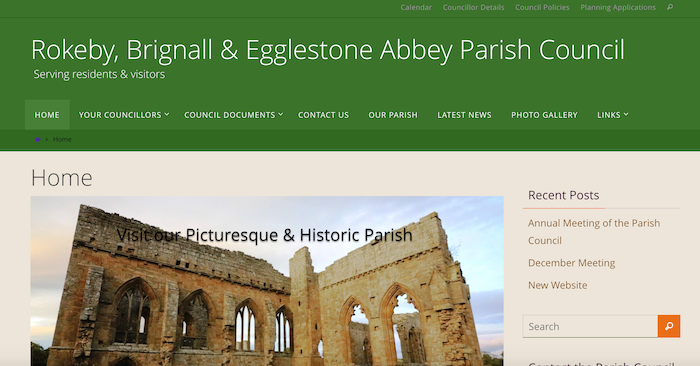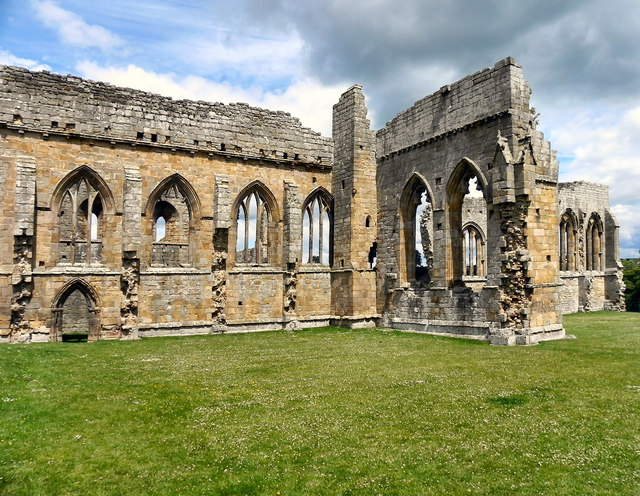Topics > County Durham > Civil Parishes in County Durham > Egglestone Abbey Civil Parish
Egglestone Abbey Civil Parish
About the Parish
Egglestone Abbey Civil Parish in County Durham is located about 1 mile south of Barnard Castle. The north-west of the parish is bounded by the River Tees.
| Settlements: | Hamlet near Egglestone Abbey |
| Population: | <100 at the time of the 2021 Census (parsh records are held with Rokeby) |
| Area: | 2.6 km² |
| Parish Council: | Rokeby, Brignall & Egglestone Abbey Parish Council (joint council with Rokeby CP & Brignall CP). |
| Unitary Authority: | Durham County Council |
Historical |
|
| Ancient townshp: |
Townships became civil parishes in their own right in 1866 (see below). |
| Ancient Parish: |
Ancient parishes refer to the parishes before the split between ecclesiastical (church) and civil parishes in the 19th century. They had a parish church and often were composed of multiple townships and chapelries. In many cases, townships and parishes were originally based on the territory of manors from the feudal system during medieval times. Civil parishes were created following the Poor Law Amendment Act 1866, in which Church of England parishes, extra-parochial areas, townships and chapelries, became "civil parishes" which could set their own poor rate (tax). Then the reforms of Local Government Act 1894 established elected civil parish councils (or parish meetings for parishes with less than 300 residents) and created urban and rural districts. Boundaries of parishes and civil parishes may have changed over time. |
| Poor Law Union: |
Teesdale Poor Law Union, formed in 1837. Teesdale Union Workhouse was located at Barnard Castle. Under the Poor Law Amendment Act of 1834 parishes were grouped into Unions, each of which had to build a workhouse if they did not already have one. It ended the old system of locally provided poor relief which had come under strain as numbers out of work grew, following increasing mechanisation of agriculture and the economic downturn after the Napoleonic Wars, along with changing social attitudes. The workhouse provided those unable to support themselves financially with accommodation and work. Inmates were generally segregated into men, women, boys and girls. The workhouse system was abolished by the Local Government Act 1929, but many workhouses lived on as 'Public Assistance Institutions' until the National Assistance Act 1948. |
| County: |
North Riding of Yorkshire Transferred to County Durham on the 1st of April 1974, following the Local Government Act 1972. |
|
District Council: |
Startforth Rural District (part of the North Riding of Yorkshire), formed in 1894. The district was abolished and transferred to County Durham in 1974, following the Local Government Act 1972. Teesdale District (County Durham) from 1974 to 2009. The district council was abolished when County Durham became a unitary authority on the 1 April 2009. |
See also: ![]() Historic Buildings and Monuments in Egglestone Civil Parish. Note: listed buildings are generally the responsibility of the county council, rather than the parish council.
Historic Buildings and Monuments in Egglestone Civil Parish. Note: listed buildings are generally the responsibility of the county council, rather than the parish council.

from https://www.rokebybrignalland…
Rokeby, Brignall & Egglestone Abbey Parish Council
- "...The parish area consisting of Rokeby, Brignall and Egglestone Abbey lies south of the river Tees and to the west of the River Greta enjoying some of the most beautiful …
Added by
Simon Cotterill

Co-Curate Page
Egglestone Abbey
- Overview About Egglestone Abbey Map Street View Egglestone Abbey is an abandoned Premonstratensian Abbey on the southern (Yorkshire) bank of the River Tees, 1 1⁄2 miles (2.4 km) south-east of …

Co-Curate Page
Eggleston Abbey Township, 1848
- EGGLESTON-ABBEY, a township, in the parish of Rokeby, union of Teesdale, W. division of the wapentake of Gilling, N. riding of York, 1½ mile (S.E. by S.) from Barnard-Castle; containing …


from https://www.rokebybrignalland…
Rokeby, Brignall & Egglestone Abbey Parish Council
- "...The parish area consisting of Rokeby, Brignall and Egglestone Abbey lies south of the river Tees and to the west of the River Greta enjoying some of the most beautiful …
Added by
Simon Cotterill

Co-Curate Page
Egglestone Abbey
- Overview About Egglestone Abbey Map Street View Egglestone Abbey is an abandoned Premonstratensian Abbey on the southern (Yorkshire) bank of the River Tees, 1 1⁄2 miles (2.4 km) south-east of …









